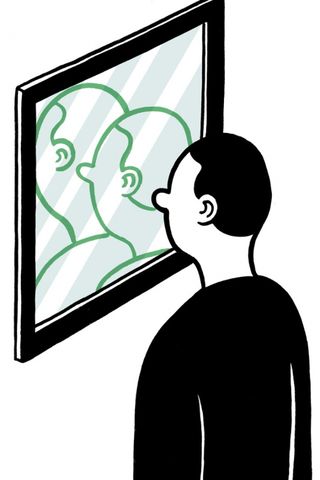
Oliver Burkeman in The Guardian (Illustration by Peter Gamelen):
The consciousness debates have provoked more mudslinging and fury than most in modern philosophy, perhaps because of how baffling the problem is: opposing combatants tend not merely to disagree, but to find each other’s positions manifestly preposterous. An admittedly extreme example concerns the Canadian-born philosopher Ted Honderich, whose book On Consciousness was described, in an article by his fellow philosopher Colin McGinn in 2007, as “banal and pointless”, “excruciating”, “absurd”, running “the full gamut from the mediocre to the ludicrous to the merely bad”. McGinn added, in a footnote: “The review that appears here is not as I originally wrote it. The editors asked me to ‘soften the tone’ of the original [and] I have done so.” (The attack may have been partly motivated by a passage in Honderich’s autobiography, in which he mentions “my small colleague Colin McGinn”; at the time, Honderich told this newspaper he’d enraged McGinn by referring to a girlfriend of his as “not as plain as the old one”.)
McGinn, to be fair, has made a career from such hatchet jobs. But strong feelings only slightly more politely expressed are commonplace. Not everybody agrees there is a Hard Problem to begin with – making the whole debate kickstarted by Chalmers an exercise in pointlessness. Daniel Dennett, the high-profile atheist and professor at Tufts University outside Boston, argues that consciousness, as we think of it, is an illusion: there just isn’t anything in addition to the spongy stuff of the brain, and that spongy stuff doesn’t actually give rise to something called consciousness. Common sense may tell us there’s a subjective world of inner experience – but then common sense told us that the sun orbits the Earth, and that the world was flat. Consciousness, according to Dennett’s theory, is like a conjuring trick: the normal functioning of the brain just makes it look as if there is something non-physical going on. To look for a real, substantive thing called consciousness, Dennett argues, is as silly as insisting that characters in novels, such as Sherlock Holmes or Harry Potter, must be made up of a peculiar substance named “fictoplasm”; the idea is absurd and unnecessary, since the characters do not exist to begin with. This is the point at which the debate tends to collapse into incredulous laughter and head-shaking: neither camp can quite believe what the other is saying. To Dennett’s opponents, he is simply denying the existence of something everyone knows for certain: their inner experience of sights, smells, emotions and the rest. (Chalmers has speculated, largely in jest, that Dennett himself might be a zombie.) It’s like asserting that cancer doesn’t exist, then claiming you’ve cured cancer; more than one critic of Dennett’s most famous book, Consciousness Explained, has joked that its title ought to be Consciousness Explained Away. Dennett’s reply is characteristically breezy: explaining things away, he insists, is exactly what scientists do. When physicists first concluded that the only difference between gold and silver was the number of subatomic particles in their atoms, he writes, people could have felt cheated, complaining that their special “goldness” and “silveriness” had been explained away. But everybody now accepts that goldness and silveriness are really just differences in atoms. However hard it feels to accept, we should concede that consciousness is just the physical brain, doing what brains do.
More here.
Dawn Herrera-Helphand at The Point:
